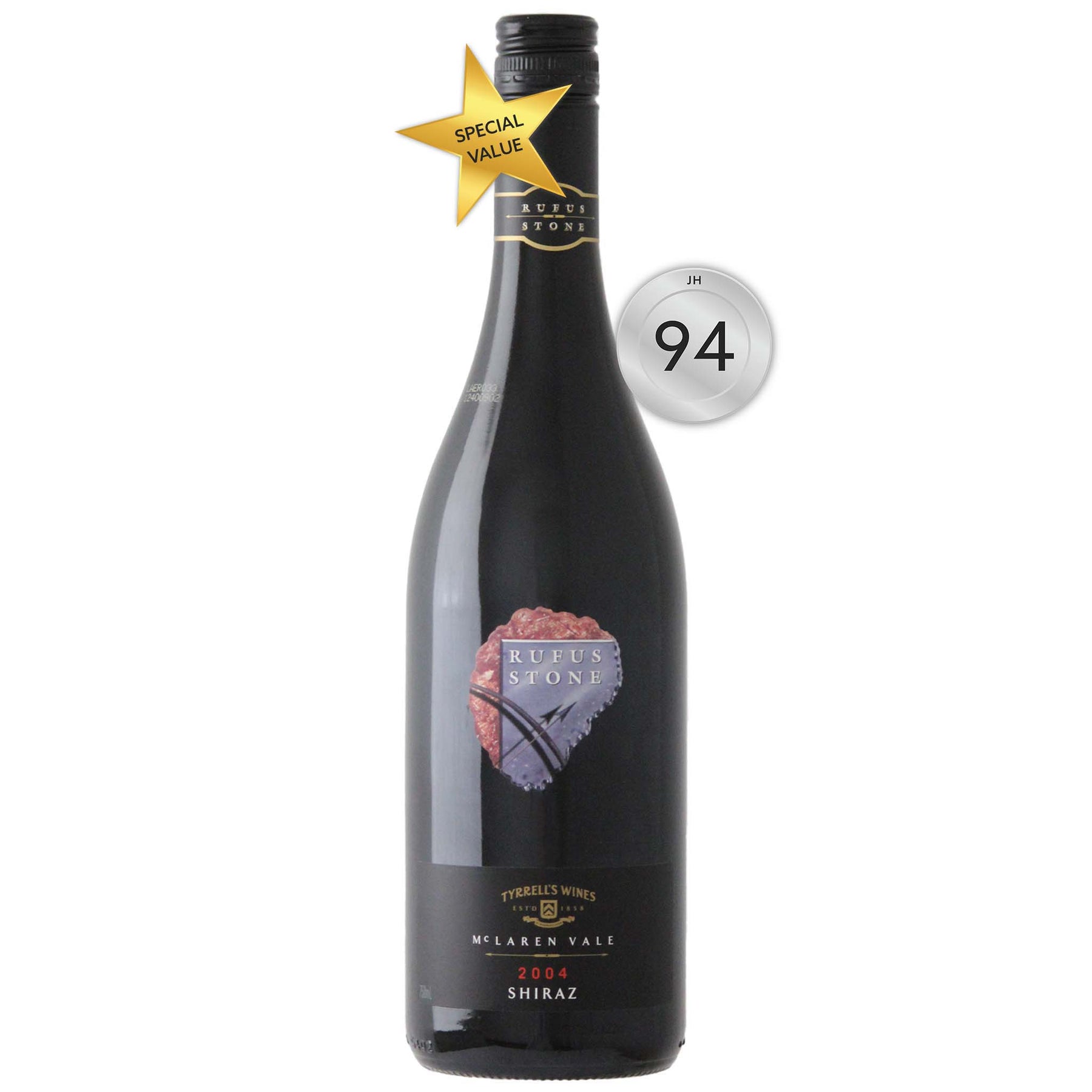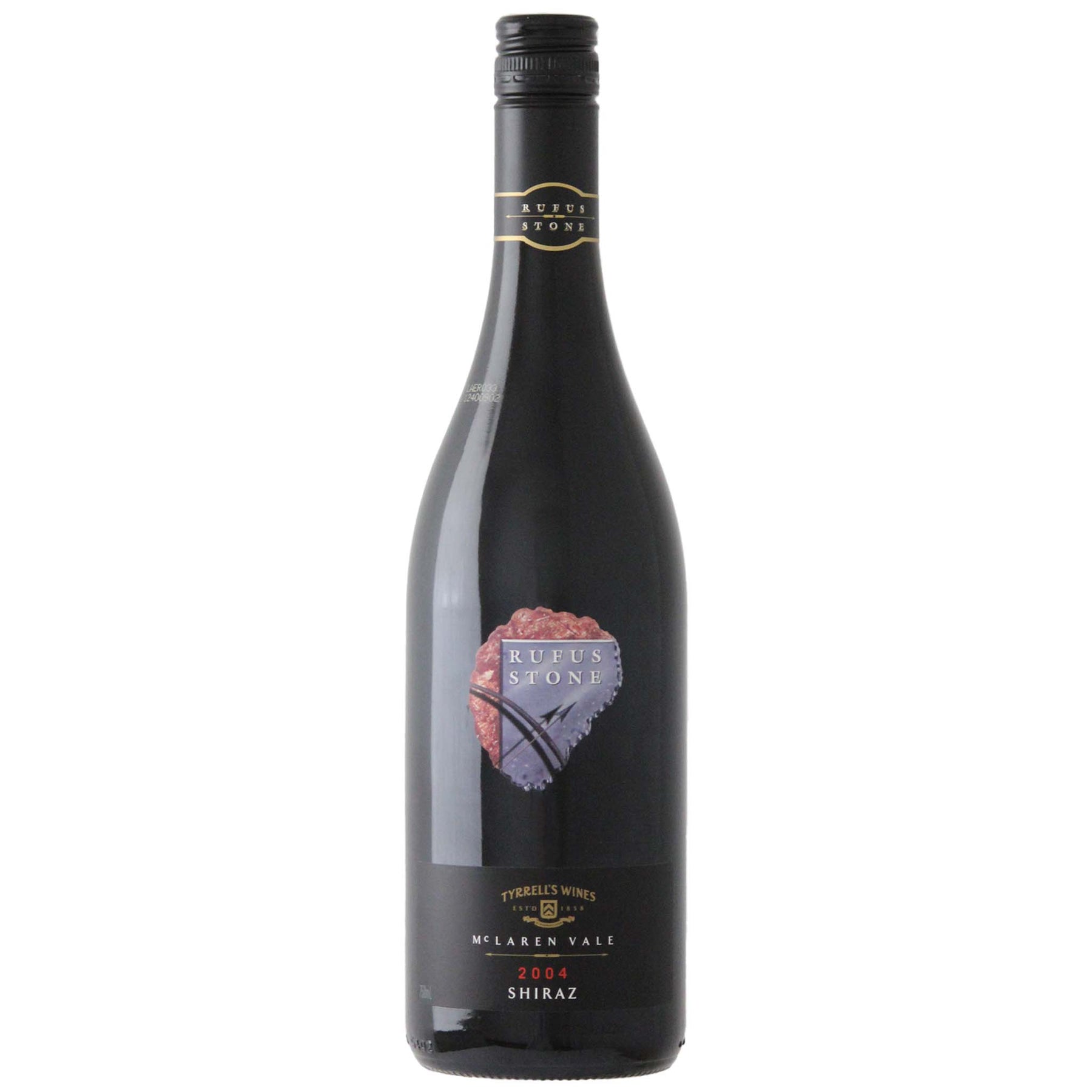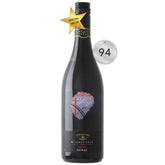

Tyrrell's Rufus Stone McLaren Vale Shiraz 2004
Style: Red Wine
Variety: Shiraz
Closure: Screwcap
Tyrrell's Rufus Stone McLaren Vale Shiraz 2004
Warehouse
34 Redland Drive
Vermont VIC 3133
Australia
Critic Score: 94
Alcohol: 14.2%
Size: 750 ml
Drink by: Now
In addition to their Hunter vineyards, Tyrrell's owns vineyards in Heathcote and McLaren Vale. Fruit sourced from these vineyards are released under the Rufus Stone label.
"Strong red-purple; medium-bodied, with excellent balance and structure; blackberry and dark chocolate on a supple palate with a long finish and restrained alcohol." James Halliday
Expert reviews
"Strong red-purple; medium-bodied, with excellent balance and structure; blackberry and dark chocolate on a supple palate with a long finish and restrained alcohol." James Halliday, Halliday Wine Companion - 94 points and Special Value Wine ★
Awards
Special Value Wine – Halliday Wine Companion ★
About the winery
 The Tyrrell family today, left to right: Jane, Chris, Bruce, John and Pauline
The Tyrrell family today, left to right: Jane, Chris, Bruce, John and Pauline
The Hunter Valley is Australia’s oldest wine region and is defined by its rich historical tapestry. There is one famous family name in the region where the great traditions of the Hunter Valley are joined by a restless spirit of wine innovation. That name is Tyrrell’s. They blend dedication to hand-crafted, minimal intervention wines while never shirking the growth and evolution of wine styles. It’s a practice that has been handed down from generation to generation, renewed with fresh vigour with each passing of the baton.
Today, the winemaking baton is being passed from fourth-generation father Bruce Tyrrell to his fifth-generation son, Chris Tyrrell. Sharing the learnings that come from over 150 vintages in one of the world’s great, unique wine regions. In a relatively short space of time, Chris has blossomed when others may have wilted under the weight of expectation. The future for Tyrrell’s is looking brighter than ever.
"In our family, it’s forever looking for the next thing. Not necessarily just for the next thing, but you are looking for the next challenge. We’ve been there, we’ve done that and we’ve got that right… What’s the next thing? How can we improve that?" Bruce Tyrrell
The founding father of Tyrrell’s Wines, Edward Tyrrell, spent his childhood growing up in Kent. In 1854 Edward moved to Australia, and four years later he and his family had settled in the Hunter Valley on a concessional allotment of 320 acres of prime land. He named the property 'Ashmans' after his maternal grandmother's ancestral home in Suffolk. Edward wasted no time building the first residence on the property, an iron bark hut that still stands today. Next was a winery in time for the first Tyrrell’s vintage in 1864. This was soon followed by more vineyards including the 4 Acres Vineyard. Planted in 1879, it is one of the oldest in the Hunter Valley and still produces exceptional fruit.
By the time of Edward's death in 1909, he had planted 70 acres of vines and produced 10 children. In the late 1800s he passed the baton on to his first and last sons Avery and Dan, the 'book-end boys' as the family refers to them, who assumed responsibility for the vineyard and winery respectively and took the business forward in the first half of the 20th century. Avery's meticulous approach to vineyard management is still bearing fruit today: "The vines that he tended so carefully are the backbone of Tyrrells' benchmark wines today, 130 years after they were planted," says Bruce. Dan, affectionately known as 'Uncle Dan', took over the mantle of winemaker at just 18 years of age and officiated over an astounding 69 vintages, surely an Australian record.
"It’s a very humbling experience to be able to go to work every day and work with vineyards that were planted by my grandfather, my great grandfather and my great, great grandfather. And while the Hunter Valley was Australia’s first grape growing region it is still a progressive wine region. No one rests on their laurels here, and at Tyrrell’s we are very much a part of that." Chris Tyrrell
In 1959, Avery's son Murray took the reins and quickly proceeded to take things to another level. Before Murray almost all of Tyrrell’s wines were sold to other wineries. Murray changed this, keeping and bottling the best wines under their own label. Before too long names like Vat 1 Semillon, Vat 9 Hunter and Vat 47 Hunter Chardonnay became part of the Australian wine lover’s vernacular. Murray also introduced new wine styles and revolutionised wine tourism in Australia, setting a new standard of excellence in innovation that his son Bruce built on since the turn of the century.
"The big change when my father took over was introducing Australia to Pinot Noir and Chardonnay of modern times. But probably more importantly he was the real father of wine tourism. In the 1960s we had no other way of getting people to buy our wines, we had to get them to come to us!" Bruce Tyrrell
Bruce Tyrell graduated from the University of New England in 1973 with a Bachelor of Agricultural Economics and joined the family business full-time a year later at the age of 23. In 2000, he took over from his father Murray as managing director of Tyrrell’s. He quickly jettisoned the Long Flat brand that focused on quantity, giving the winemaking team the chance to focus on Tyrrell’s single-vineyard, sacred site and winemaker’s selection wines. The results? Tyrrell’s global reputation for exceptional Semillon and Chardonnay is now matched by a reputation for their reds that is the envy of many in the valley and across Australia.
Just as Avery and Dan learnt from Edward, and Bruce learnt from Murray, today Chris Tyrrell is learning each day from Bruce and the rest of the team in the vineyard and in the winery. Like Bruce, Chris isn’t just blindly following the path others before him have forged - he wouldn’t be a Tyrrell if he wasn’t looking to improve, innovate and evolve.
Rather than looking to the modern or the technical to improve the way things are done at Tyrrell’s, Chris is actually heading back to the past while looking to the future. Back then apart from a few rudimentary tools in the vineyard and winery, it just took a heck of a lot of work to get the grapes getting grown, picked, crushed, fermented and bottled. Over the years there have been many machines, tools and gadgets that have removed the amount of hard work needed in the vineyard and in the winery. Some of these tools have been invaluable in improving the quality of wines made around the world. But other tools have reduced the connection between the vigneron and the land, making it harder to truly express a sense of place.
"A lot of the wineries in the region, including us, have been dusting old bits of museum equipment and bringing them back to life. For us it’s the basket presses and old bits of vineyard gear and old plows… Everyone, especially with viticulture, is going back to the way things used to be. Doing right by the vineyard and doing right by the soil." Chris Tyrrell
Chris has been a key influence on processes in the vineyard and in reviving minimal intervention winemaking traditions in the winery. The result? The wines are in better shape than ever. Chris has been recognised and awarded as one of the best young winemakers in Australia. He was a finalist in the Young Gun of Wine Awards in 2016 and took part in the Australian wine community’s Future Leaders program for the industry’s best and brightest, just a few of the accolades in his short career.
In the rich and colourful history of Australian wine there are many names that have shone brightly but ultimately failed to create a lasting legacy. No such concerns with the Tyrrells of the Hunter Valley. The solid foundation built by Edward, grown by Avery and Dan, shared with the world by Murray and matured into one of Australia’s great family wineries by Bruce, is stronger and tasting better than it ever has. Chris Tyrrell, one of Australia’s brightest young winemakers and fifth generation family member, is now taking this special legacy and shaping it for the future. An illustrious history. A bright future. The Tyrrell’s name and fine Australian wine will be synonymous for many, many years to come.
The majority of the text above is taken from an article 'Like father, like son' in https://www.wineaustralia.com/
The Winemaker

Having first thought he was going to be a chef, Andrew Spinaze fell into winemaking after working for a while in 1978 at Arrowfield in the Upper Hunter. He then decided to take a potshot at Adelaide's Roseworthy Agricultural College’s wine marketing and making course, completing his studies in 1980. "Ninety percent of what we did was winemaking, including practical work at a winery. Mike de Garis introduced me to Tyrrells and I worked there during the really hot vintages of 1980 and 1981. Six months later I was invited to return, which I thought I’d do for around twelve months", he says. Forty-two years later, he’s still there and not going anywhere.
Given the importance of chardonnay to Tyrrell’s in the 1980s, it says something for Murray Tyrrell’s judgement that he allowed one of his senior winemakers, John Cassegrain, to persuade him to put the company’s entire chardonnay production into the hands of the raw and unproven Spinaze. From Vat 47 downwards, Tyrrell’s chardonnay has never looked back, hardly even sideways.
In 1985, Spinaze was promoted to Assistant Winemaker to Mike de Garis. After travelling to France in 1987 to fine tune his winemaking skills, Andrew was appointed Chief Winemaker in 1989, overseeing all winemaking operations at both Tyrrell’s lower and upper Hunter wineries, with an overall crush of 4,000 tonnes.
During Andrew’s time with Tyrrell’s, the firm has successfully made the transition from small family winery to a major Australia wine company. When asked to pick the three biggest highlights of his career so far, he replied:
"From a production point of view, evolving new techniques over the last 30 years and watching how the wines mature as a consequence – it’s given me a great sense of achievement. This has led to the development of an extensive Single Vineyard portfolio which gives great integrity throughout the business from vineyard to consumer.
Secondly, I would say having worked with a great bunch of people close to the winemaking team. When you have people that have stayed with you for over 20 years they offer amazing experience and knowledge.
Thirdly, I’ll be indulgent and say having won QANTAS and Gourmet Traveller Wine Magazine Winemaker of the Year in 2004 was great."

South Australia
South Australian is responsible for more than half the production of all Australian wine. It is home to more than 900 wineries across 18 wine regions. The regions are Adelaide Hills, Adelaide Plains, Barossa Valley, Clare Valley, Coonawarra, Currency Creek, Eden Valley, Kangaroo Island, Langhorne Creek, McLaren Vale, Mount Benson, Mount Gambier, Padthaway, Riverland, Robe, Southern Fleurieu, Southern Flinders Ranges and Wrattonbully.
Many of the well-known names in the South Australian wine industry established their first vineyards in the late 1830s and early 1840s. The first vines in McLaren Vale were planted at Reynella in 1839 and Penfold's established Magill Estate on the outskirts of Adelaide in 1844.
South Australia has a vast diversity in geography and climate which allows the State to be able to produce a range of grape varieties - from cool climate Riesling in the Clare and Eden Vallies to the big, full bodied Shiraz wines of the Barossa Valley and McLaren Vale. Two of Australia's best-known wines, Penfolds Grange and Henschke Hill of Grace, are produced here. There is much to discover in South Australia for the wine lover.

